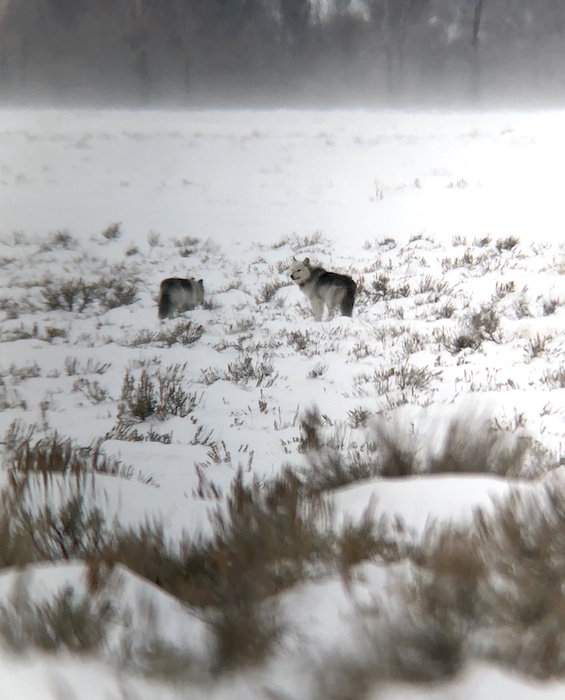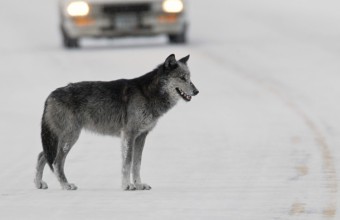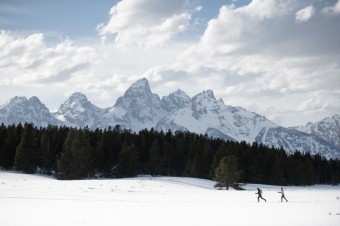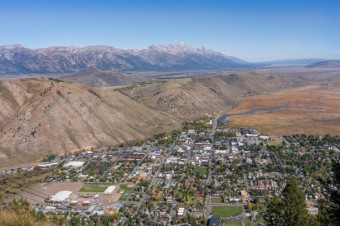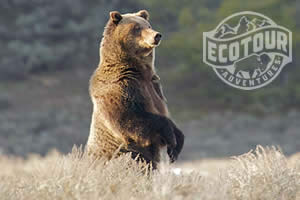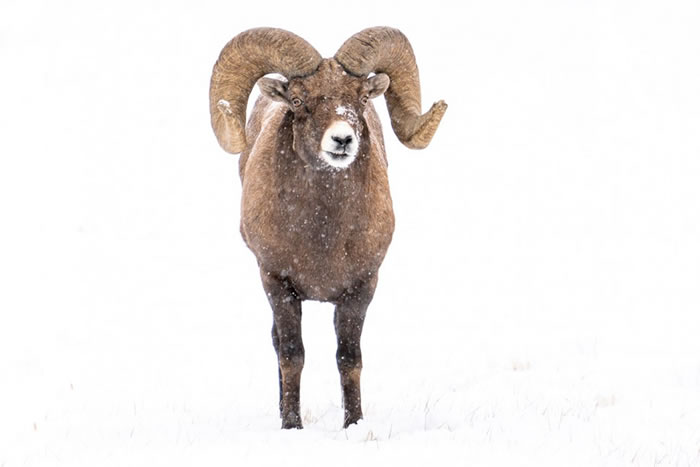
It’s late winter in Jackson Hole. With over 400 inches of snow blanketing the peaks of Grand Teton National Park, the landscape appears silent, yet life abounds here. Our valley lies in the heart of the Greater Yellowstone Ecosystem, and each winter wildlife both large and small concentrate here to endure winter.
Finding wildlife in winter can be as easy as watching elk herds of the National Elk Refuge or as difficult as spotting a camouflaged great gray owl against the similar texture of cottonwood bark. Either way, learning the best places to see wildlife in Jackson Hole is the first step. With another month of winter to go as spring approaches, here are some of our favorite spots and what to look for!
Miller Butte in the National Elk Refuge
Departing Jackson’s Town Square, head east on Broadway until the paved road ends and follow the dirt road onto the National Elk Refuge. As late winter turns to spring on the Refuge, look for fresh dirt piles in the snow. These are evidence of badgers hunting for hibernating ground squirrels!
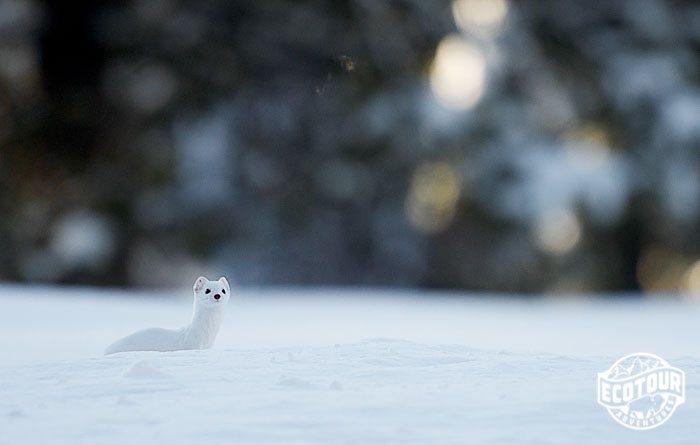
Long-tailed weasels, a smaller relative to the badger are sometimes seen sprinting across the flats of the National Elk Refuge. Dozens of mammal species and hundreds of bird species also call this landscape home
Look for eagles and other birds roosting in the cottonwood trees above the historic Miller House before arriving at Miller Butte. In winter, the Gros Ventre bighorn sheep herd migrates out of the mountains to these slopes, taking advantage of the sunny, wind-scoured slopes. The cliff bands of Miller Butte also provide refuge should a coyote, wolf, or mountain lion (all of which are found on the Refuge!) approach.
As winter progresses into spring a mating pair of prairie falcons returns to their nesting site in these cliffs, a welcome sight for avid birders. Beyond the butte, a vast view of the nearly 25,000-acre Refuge emerges, we love to glass from here with our Maven S.1 spotting scopes in hopes of catching the Huckleberry wolf pack.
East Gros Ventre Butte
My first winter in Jackson Hole, I spent many days driving into the park fixated on the promise of skiing in the Tetons, oblivious to the hundreds of animals wintering on the slopes above the road to my left. Many of the mule deer who raise fawns in Grand Teton National Park during the summer return to the Butte each winter, retracing the steps their own mothers taught them. Like the bighorn sheep across the Refuge, mule deer use these slopes because prevailing winds help blow the snow off sagebrush and other shrubs which are their primary food source.
Winter is tough on our ungulates, or hoofed animals, and some unfortunately succumb to starvation, exposure, or to vehicle strikes along HWY 89/191. Though we are working to reduce wildlife-vehicle collisions in Teton County, (read about our efforts here!) these winter kills do provide much-needed sustenance for bald and golden eagles, ravens, magpies, foxes, coyotes, foxes and dozens of other species. There is no waste in nature.
The National Museum of Wildlife Art is one of our favorite places to visit and also glass for wildlife. If you tour the museum, be sure to check out our EcoTour Adventures Spotting Scope in the Members Gallery and look for wolves, coyotes, and eagles along with over 8000 elk who reside on the National Elk Refuge in winter.
This year the Huckleberry wolf pack has moved south onto the National Elk Refuge, displacing the Pinnacle Peak pack from an area they had roamed for years. The arrival of this new pack has made for great wolf watching on the Refuge, and each viewing location listed here provides different opportunities to look for them.
One final location to look while on the Refuge is from the Fish Hatchery. The pond nearby stays unfrozen year-round providing consistent opportunities to look for a multitude of duck and waterfowl species including gadwall, bufflehead, ringneck, goldeneye, trumpeter swans, hooded merganser and others. The willows in this area may also hold some of the first returning songbirds of spring, including song sparrows, red winged blackbirds, and the stunning mountain bluebird.
Be sure to check the fence posts and power lines along the Refuge for a medium-sized raptor who has traveled over 2000 miles to get here. The rough-legged hawk, similar in size to our more common red-tailed hawk winters in the lower 48 states before returning to nesting territories in the arctic circle. It’s one of just a few species who migrate to, instead of away from the GYE in winter.
Grand Teton National Park
In summer, wildlife watching in Jackson Hole largely occurs in Grand Teton National Park, but in winter deep snows have pushed most large animals to lower elevations. Not so for our largest deer, the moose. With their long legs and high stepping gait, moose are perfectly adapted for snow and as a result, they have a “circumpolar” distribution around the world. Earlier in the winter moose concentrate in the sagebrush flats of Antelope Flats, but as the snow deepens they return to rivers such as the Snake or Gros Ventre where they can wade in the water to reach food sources.
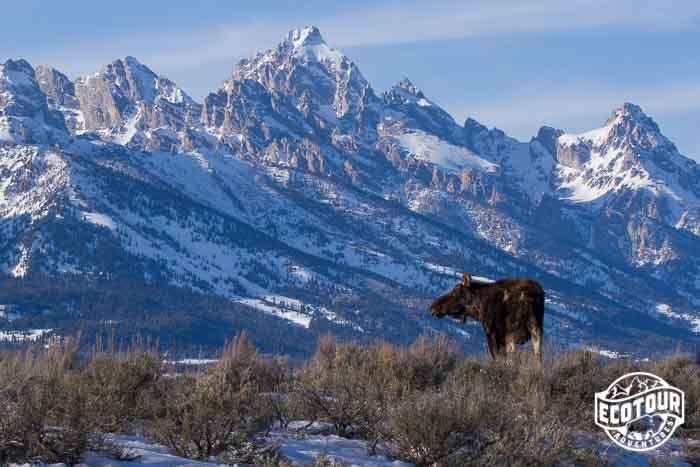
As the snow begins to recede in the valley in late winter Antelope Flats is a great spot to look for Greater sage grouse. These “wild chickens” gather to mate on lek sites throughout late March and April. A ‘lek’ is a location where males of a species concentrate to display and hopefully attract mates. Grand Teton has one near Mormon Row, though on deeper snow years we’ve seen males displaying on windswept ridges elsewhere in the Park. As you look for wildlife in southern Grand Teton also keep an eye out for the first western meadowlark and American kestrel of spring, they should be arriving any day now!
Rivers in Jackson Hole
Traveling along rivers in winter is a sure bet to see wildlife. As we’ve already discussed, moose, along with waterfowl and eagles use this open water to feed. My favorite river bird, the American dipper, is also at home in the water. Watch for a monotone gray bird a bit smaller than a robin flitting about in and out of the water. If you catch one it will likely dip on its rock perch before diving underwater to pull aquatic macroinvertebrates from the river bottom.
Bald eagles are starting to return to nest sites along the river, and may even be incubating eggs! Look for large stick nests in cottonwood trees near the river for a chance to catch a glimpse of these large raptors.
We’ve also been enjoying great otter sightings this winter in some of the creeks and rivers of Jackson Hole. Beaver ponds with open water can be a great place to look, as well as Jackson Lake Dam or any time you are along the Snake River. Otters often slide along through the snow on their bellies, look for drag marks in the snow to help locate these playful mustelids.
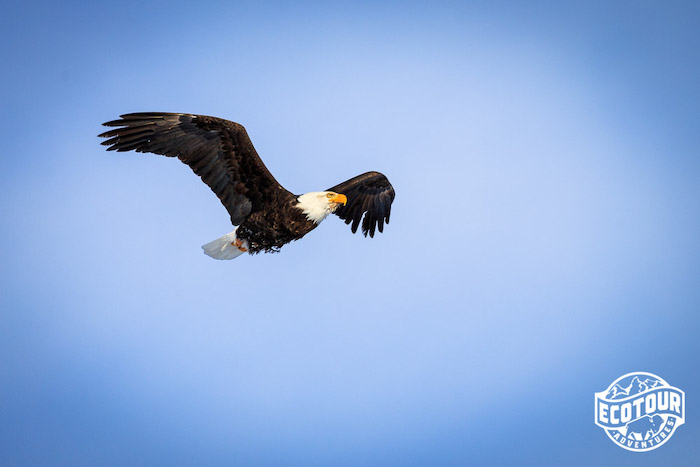
Northern Grand Teton
By mid winter, most of our wildlife viewing while snowshoeing or cross-country skiing in Northern Grand Teton consists of the tracks of coyote and fox, ermine, American martin, and the prey they pursue, including mice, voles, snowshoe hare, and squirrel. But soon enough more creatures will appear.
Grizzly bears start to stir in March, and by mid April we usually have our first sightings in the northern part of the park. (Read more about bear safety here). Bears seek out freshly melted out areas to dig for edible roots and small mammals while sniffing around for the scent of winter-killed animals to scavenge.
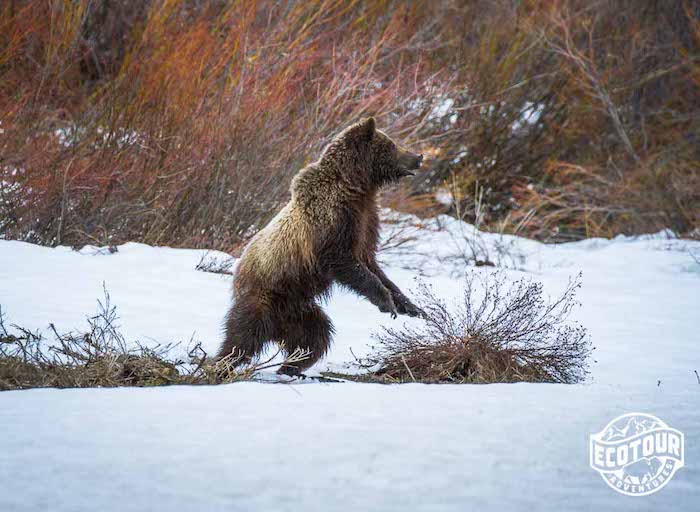
The fantastic mammal migrations of the Greater Yellowstone Ecosystem also begin in late winter. Soon, thousands of elk, deer, and pronghorn antelope will make epic migrations across the ecosystem, gorging on the lush green vegetation which follows melting snows. These migrations are a sight to behold, you can almost feel the landscape take a big inhale as it wakes up from the long winter.
Responsible Wildlife Watching
Now that you are familiar with some of the best spots to look for winter wildlife in Jackson Hole, it's important to remember that this is the hardest time of year for many of these animals. That’s why Ecotour Adventures is a business sponsor of the Don’t Poach the Powder campaign, which seeks to educate the public on critical winter wildlife habitat closures throughout the valley.
By viewing wildlife from afar with our Maven binoculars and spotting scopes we seek to avoid disturbing wildlife who are relying on finite fat reserves to get through the winter.
It’s a great time of year to see the winter wildlife of Jackson Hole, if you liked this article please share it (LINK ON FB) and let us know what you think in the comments! Also consider joining one of our experienced guides on a premium wildlife safari of Grand Teton this winter or spring, it’s an experience you won’t forget.
You can view live availability 365 days a year online via the “Book Now” button, call us 307-690-9533 or email info@jhecotouradventures.com for more information.
- Story by Naturalist Josh Metten, see more of his photos on Instagram: @joshmettenphoto
Guest Testimonials:
“I had a wonderful time on Eco Tour Adventures’ Winter Wolves and Wildlife Tour. The diversity of the tour, and the knowledge of the guide, was incredibly satisfying and I learned and enjoyed it so much.” - Joan, NY
“I was very impressed with the guide, his knowledge, and all of the attentiveness to detail and caring about each one of us! I learned so much and it was also such an enjoyable getaway for our family. I highly recommend you take a trip with Jackson Hole Ecotour Adventures.” - Sarah, NM


